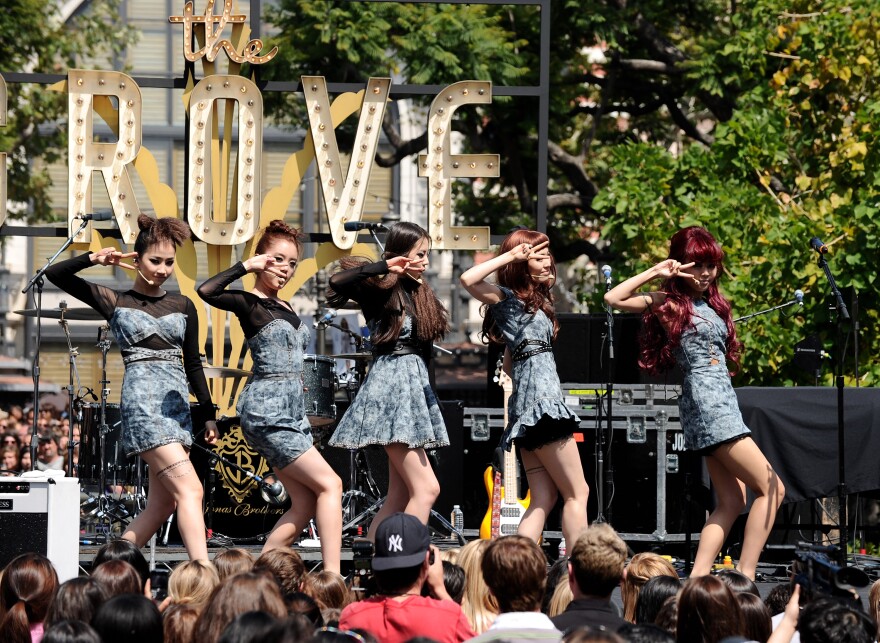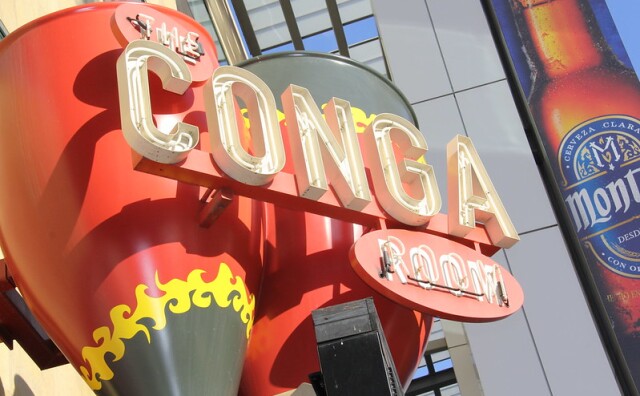K-pop has exploded to new heights in the past few years. From Grammy nominations for BTS, to BLACKPINK headlining this year’s Coachella Music Festival — K-pop groups are some of the biggest musical acts in the world.
K-pop — shorthand for Korean popular music — isn't brand new, the genre has been around for decades. And from the very beginning, some legendary performers helped shape it into the global phenomenon that it is today.
In LAist Studios’ new podcast, K-pop Dreaming, listeners follow the rise of K-pop through the perspective of the Korean American diaspora in Los Angeles.
For newbies looking to get into the scene, it can be a little overwhelming. There's a whole sea of groups and corresponding members to dive into. To get you hooked, our team made you this virtual mixtape of some of the most iconic songs in K-pop history.
And for you long-time fans, we hope it brings back some great memories.
1: 'Candy' (H.O.T 1996)
H.O.T., which stands for “High Five of Teenagers,” marks the start of what many consider the first generation of K-pop. Formed by Lee Soo Man, founder of entertainment giant SM Entertainment, H.O.T. was the first K-pop group to go through the idol system.
It works like this: Entertainment companies audition aspiring K-pop idols, train them to sing and dance, assemble select trainees into groups, debut those groups and then manage and produce every aspect of their careers. This system is the foundation of the industry today. The music and culture that comes from this system — that makes up the K-pop industry.
As for H.O.T. — they became extremely popular, especially among teenage girls in South Korea. With their fun, poppy melodies, catchy dance moves and trend-setting “snowboarder aesthetic” fashion — H.O.T. was a revolutionary moment in K-pop.
2: 'Couple' (커플)
By SECHSKIES 젝스키스 1998)
Following H.O.T.’s debut, other companies started debuting their own groups that followed the formula established by SM Entertainment. One of those groups was SECHSKIES (pronounced: ZEKS-kees), meaning “six crystals.” Like H.O.T., SECHSKIES blew up in popularity — bringing in their own devoted fans. And the first fandom rivalry in K-pop was born.
From the start, K-pop fans were super dedicated and organized. There were official fan clubs, with presidents and members. Each fandom was identifiable by an official color, which fans would rep at concerts. H.O.T. fans wore white raincoats and held white balloons. SECHSKIES fans wore yellow raincoats and held yellow balloons.
Sometimes, the competition would get heated at music television shows, where different K-pop groups would perform in the same show, in front of a live audience. Fandoms would compete during show tapings to cheer for their group the loudest.
3: 'Dreams Come True'
By S.E.S. — 1998
After H.O.T’s debut, SM Entertainment launched its first girl group, S.E.S. The acronym stands for the three members’ names, Sea (or “Bada” in Korean), Eugene and Shoo. S.E.S. was one of the first ever K-pop girl groups, and they’re often heralded as trailblazers for all the girl groups that followed.
-
Nonprofit's launching fundraiser to keep it afloat
-
USC study documents what residents want from trees
-
What candidates can — and can't — say they do
S.E.S. grew popular for their cute and wholesome image. This song, “Dreams Come True,” was dubbed to have an “innocent fairy” concept.
Concepts — a specific visual and conceptual theme — are a key part of K-pop. K-pop groups today still use concepts when introducing a new group or announcing a new album. For example, some popular K-pop concepts include “high school student,” “supernatural” or something as simple as “sexy.”
S.E.S. was part of a wave of popular first-generation groups. By the mid 2000s, many of those groups came to an end. Groups disbanded for a variety of reasons, including conflicts with their companies and career moves for certain group members. While those first-generation groups were tapering off, a whole new wave of artists and groups started entering the scene — ushering in the second generation of K-pop, also known as “The Golden Age of K-pop.”
4: 'Gee'
By Girls’ Generation (소녀시대) — 2009
Girls’ Generation is among the groups at the helm of second-generation K-pop. The group debuted with nine members and a wholesome, girl-next-door image. Girls’ Generation, like many of the second generation groups in this era, reached a level of fame that wasn’t possible before. Much of that exposure was possible because of the advent of YouTube in 2005.
Through YouTube, people outside of Korea were able to access K-pop music videos in ways they hadn’t been able to before. Fans from all over the world spent a lot of time learning K-pop dances, filming dance covers and posting them on YouTube.
Dance is a huge part of K-pop performances. There’s even a term for it — “point choreography” — meaning, the catchy, signature move of the song’s choreography, typically used in the chorus. For “Gee,” the point choreography was the “crab leg dance,” where the girls move side to side as their feet move in and out, like how a crab skitters across the ground.
5: 'Nobody'
By Wonder Girls — 2008
Wonder Girls is another iconic second generation group and their song “Nobody” featured a Motown-esque concept with a retro-pop sound. “Nobody” became the first K-pop song to crack the U.S. music charts, and Wonder Girls started showing up on American TV shows like “So You Think You Can Dance” and “The Wendy Williams Show.” They even went on tour with the Jonas Brothers as their opening act.
Crossing over to the U.S. market is a key marker for the biggest of the second generation groups. K-pop songs started cracking U.S. music charts, and K-pop groups started appearing on late night shows and collaborating with American artists.
6: 'LIES' (거짓말)
By BIGBANG — 2007
BIGBANG is one of the biggest boy bands from this era, and they stood out with hip-hop elements in their music and fashion. The music video for “LIES” features the members with edgy looks, rapping and singing while lamenting about a lover.
BIGBANG music videos, like many of the biggest second-generation groups during this time, blew up on YouTube to reach international acclaim. And many millennial K-pop fans point to second generation groups as their point of entry into K-pop as a genre.
These three groups — Girls’ Generation, BIGBANG and Wonder Girls — also represented the “Big 3” entertainment companies that dominated the era during this time. SM, YG and JYP. Each of these companies was headed by a former artist turned producer, and all three were responsible for creating the biggest K-pop groups and artists at the time.
7: 'Gangnam Style' (강남스타일)
By PSY — 2012
While second-generation groups were steadily making strides to break into the U.S. market, no one predicted the wild card that was PSY. PSY is a rapper who had been making music independently for most of his career before signing with YG Entertainment, one of the Big 3. He had mainly been operating outside of the K-pop sphere, so it was unexpected that his song blew up to the scale that it did.
When PSY dropped the music video for “GANGNAM STYLE,” it quickly overtook “Call Me Maybe” by Carly Rae Jepsen to become the top viewed music video on YouTube. PSY became a viral sensation and performed at Dodger Stadium, went on The Ellen DeGeneres Show and made an appearance on Saturday Night Live.
It seemed everyone was singing the song and doing the invisible horse dance. K-pop had finally captured the world’s attention in a completely unprecedented way. PSY’s success transformed the genre of K-pop forever — and ushered in a new generation of groups who rose to reach international acclaim.
What's next
In the decade since “GANGNAM STYLE” captured the world’s attention, third-generation groups like BTS and BLACKPINK have grown to shape K-pop into a global genre. The expansion of social media played a part in both of those groups’ successes, giving fans even more power than ever before.
Now, fourth-generation groups like Aespa are coming out with future-forward concepts involving AI and the metaverse. Other fourth-generation groups, like NewJeans, are returning to a Y2K style with their retro sound and fresh-faced image.
What’s next for K-pop? Only time can tell — but it’s clear that the genre is here to stay.
Listen to the first two episodes
And please subscribe wherever you get your podcasts!








